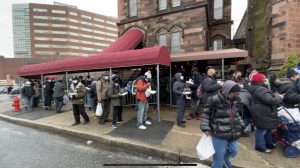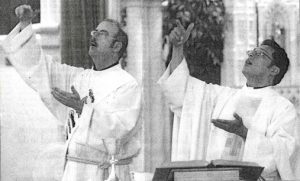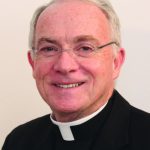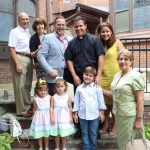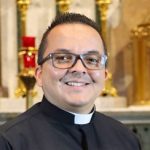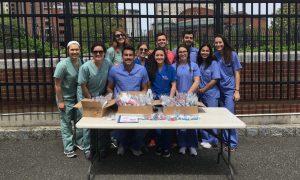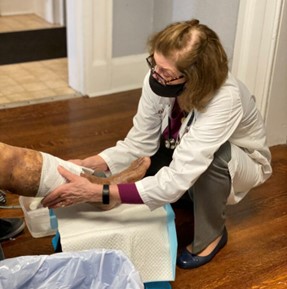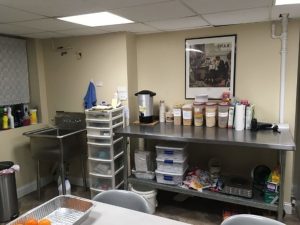Monsignor Hourihan
In the latter 20th century, the parish once again appeared to be dying. According to newspaper reports there were only twelve parishioners in 1969 and, in 1977, just two families. Its geographic boundaries were Market Street to the south, Broad Street to the west, Bridge Street to the north, and the Passaic River to the east – an area of diminishing private residences. St. John’s was not a desirable parish on the list of most priests.
But then, in 1972, Archbishop Boland appointed Monsignor John Hourihan, a human hurricane, as pastor (pastor, 1972-1997). Four years later, as the parish celebrated its 150th anniversary, Monsignor Hourihan considered St. John’s as a poor, but very much alive, parish.
In a letter to volunteers who offered to paint the church and rectory in 1976, Joseph F. Zoppi, Jr., wrote: “Father John of St. John’s refuses to accept the story that Newark is a dying city, and that St. John’s will not survive as a church of Newark.” Zoppi organized dozens of volunteers as well as donations of paint and supplies from various hardware stores and paint manufacturers such as Sherwin Williams and Benjamin Moore.
150th Anniversary Press Release – 1976
A press release after the 150th anniversary of the parish summarized Hourihan’s impact through a description of the activities of the anniversary year.
In recent years as the city’s prominence declined so did St. John’s. For years it struggled along…and there were frequent reports it might be closed. Then, four years ago, Monsignor Hourihan became its pastor…and all changed for the better.
The 150th celebration year was literally one memorable event after another.
The parish commissioned a pen and ink sketch of the church by Greenwich artist Philip Camporeale and presented it to Archbishop Gerety; the Archbishop himself blessed and distributed ashes to hundreds of worshipers at St. John’s on Ash Wednesday; a $10,000 Meditation Garden, built entirely by volunteers and donated funds, was dedicated next to the church; an unusual Italian Mass was held to mark the first Italian language sermon at Mass at St. John’s 100 years ago. Monsignor Hourihan joined with Episcopal Bishop Rath to celebrate Newark’s Brotherhood Week… and to cap it all, the United States Department of the Interior placed the church on the National Register of Historic Places.
St. John’s is also well-known for its charities to the poor, the handicapped, aged, elderly, and ill. In 1975 the church served 6,000 meals to the needy who came to its doors – and with the help of young college volunteers it visited, fed, consoled,and nursed the numerous ill and elderly who live in furnished rooms nearby.
160th Anniversary Booklet – 1986
Ten years later, further progress and activities were described in a booklet printed to commemorate the parish’s 160th anniversary. The booklet showed that the parish’s mission was firmly grounded in theological principles.
Today, St. John’s, which is a symbol of survival in a city that is experiencing a renaissance, is a small parish with a mammoth mission. It serves the commuters, the handicapped, the homeless, and the hungry. Its pastoral thrust has caught the attention of the media because it represents authentic Christianity interpreting the teachings of Christ by word and example in order to meet the needs of people in meaningful ways.
The faith of its founders lives on in those whose faith today gives new life to this old church.
The mission of the People of God at St. John’s is based on a mystical model described in the statement made at Baptism which proclaims that the new Christian is “one with Christ – Priest, Prophet, and King.”This mission is to give witness in love and truth to Christ in these three roles. Giving such witness, the parish becomes part of salvation history, a wonderful encounter of the divine and the human. Its witness is unique because it is given by a faith-community consisting of parishioners and comuters who work in the business district.
St. John’s gives witness to Christ as Priest through forms of worship and ministries that are meaningful; namely, through liturgies that are related to our growth in love of God and neighbor at home and at work and through opportunities which allow a freedom of religious expression based on all the options given to the People of God.
The Parish gives witness to Christ as Prophet through updated doctrine that is reflected in homilies, catechesis, evangelization, and ecumenism which reflect the teaching of our Archbishop and Pope. It is also refected in action through the various apostolates performing the Corporal Works of Mercy.
Its people gives witness to Christ as King, alive in a world in which salvation involves temporal matters. This means that building Christian community includes the prudent use of material things with a Christ-like approach to organization and administration. As such it presents a model different from worldly models.
In striving to accompllish this mission the pastor and people through cooperation and consultation want to be a Resurrection people in a re-born Newark.

Monsignor Hourihan brought energy and imagination to the parish that it had not seen since the days of Father Moran, more than a century earlier. He not only recognized the needs of the growing numbers of poor and often homeless people in Newark, but he also addressed them.
Hourihan was active beyond the boundaries of the parish, and beyond the boundaries of Newark and New Jersey. He was a member of President Kennedy’s advisory committee on teacher training. In addition, he served as an advisor to the Department of Health, Education, and Welfare during the administration of Lyndon Johnson. President Jimmy Carter also appointed him as vice chairman of the National Conference on the Handicapped.
The Gateway Mass
He described the parish as “an oasis in a desert of parking lots.” In order to reach out to the neighborhood and its transient population of commuters, he initially set up chapels in the nearby Gateway Center office complex. There Mass was celebrated on holy days. On Ash Wednesday, 1977, more than 3,000 people attended more than 17 Masses in these two locations. In 1978, a permanent Interfaith Chapel was built in the Gateway Center. For many years, Mass was celebrated in this chapel.
Gateway Interfaith Chapel Plaque
In May 1974
The First Religious Services
Leading to the Erection of an
Interfaith Chapel
Were Held Here
The Gateway Center
Honors those Clergy and People
Whose Personal Experience Of
Faith and Love in the Chapel
Gives Hope to All Who Use
Their God-given Talents
In the Market Place
May 1984
The Soup Kitchen

The city of Newark has a large population of poor people. Initially, Hourihan and two deacons brough meals to homeless people in nearby welfare hotels. He soon established St. John’s Soup Kitchen, which has served over three million meals since its inception. It is staffed by volunteers from the suburbs, school children, university students, and workers from nearby corporate offices. It is supported by free-will donations from thousands around the state and nation and receives no help from the archdiocese or the civil government.

The Soup Kitchen describes its mission very simply.
Helping Those in Need
St. John’s Soup Kitchen has one mission and that is feeding the hungry. For over 40 years we have been providing food to those who have none in the Newark area. Few people know what it’s like to go without food, but every day guests come to our kitchen to eat. Today with your help, we can continue helping many of our fellow men, women and children who have fallen on hard times. It is up to all of us to make a difference in the communities we live in.
Art Exhibits
St. John’s also reached out to the wider community, hosting concerts of the Newark Boys Choir and art exhibits in the side chapel, in 1975 converted into an art gallery. The Sixth Annual Exhibit of Religious Art in St. John’s in 1981 featured 119 entries, of which forty-one made it into the show. The themes of the art were “spiritual,” although not necessarily religious. The avant-garde character of these exhibits can be seen in the news report of the 1981 exhibit.
Ed Newbury took the first prize in painting with his large canvas. “Cruciform with Red Horizontal” The two stacked panels are both painted black; across the center is a black band, distinguishable only for its brushstrokes and a line of red along the division. Visually simple, the piece seems to symbolize the darker side of its subject, the apparent triumph of evil and violence over hope and love.
Donna L. Ciangio took a second in painting and collage for “Let Dry Land Appear,” a graceful composition that plays triangular rifts of torn, white paper against a watercolor-tinted background. Ciangio also received an Honorable Mention award for her pencil drawing, “Contemplation” a delicate work that resembles the shaft of a feather suspended on a white background.

After several decades, the gallery was converted into the indoor dining area for the Soup Kitchen. St. John’s continues to adapt to need.
The need came out of a frigid winter day that forced us to open the church to allow the men to eat there. Barbara Moran was skeptical and concerned that a fight might break out; but I said, we are doing what God asked us to do, let Him take care of the rest. And so, we opened tables and chairs and invited the men to come in. They were so grateful that we allowed them to eat in the church.
From that day on we decided to clear out the Art Gallery, fix it, and turn it into a dining room for men. I wrote this story in my monthly letter to the donors and the donations began to pour in. The Parish of The Guardian Angel in Allendale donated the tables and chairs, and we were able to raise the money to fix all water damage in the room and the roof. When we opened it Archbishop Myers came to bless it. It really was a blessing. – Father Bismarck
The Deaf Ministry

As if this was not enough, Monsignor Hourihan, who had for decades devoted himself to the ministry to the deaf, initiated a deaf ministry and a regularly scheduled sign language (ASL) Mass at St. John’s.
Monsignor Finnerty and the New Millennium
Monsignor Hourihan retired in 1997 and was succeeded by Monsignor James Finnerty, who continued and enhanced the apostolates of Saint John’s Parish.

The Sunday Star-Ledger
August 26, 2001
By Patricia d. Turner
Star-Ledger StaffOne hundred and seventy-five. Three hundred. Half a million.
These numbers add up to a special story for 1.3 million Roman Catholics in the Archdiocese of Newark.
The mother church of all of their parishes, St. John’s in Newark is celebrating its 175th anniversary this year and will hold a Mass on Sept. 9 to commemorate the occasion.
As for the other numbers. There are only three people who live in the parish and attend Mass there. The other 40 or 50 at Sunday Mass drive in from the suburbs.
And the parish budget, most of it for the feeding program, is more than $500,000 a year, with no contributions from the archdiocese or government.
“This is all free-will donations, $5, $10, $25, $100,” said Deacon Michael Malone, pastoral associate, and business manager. “Rarely, we’ll get a bequest, but 99.9 percent of it comes from our 14,000names on the database of donors and volunteers.
St. John’s has served more than 1.5 million meals since the early 1970s, when then-pastor Monsignor John Hourihan started the project.
St. John’s Feeds the Hungry turns to volunteers – about 200 at any one time, as many as 800 overall – from nearby businesses like Prudential and the Law Center as well as congregations as varied as Baptists and Mormons.
Students lend a hand, as do youngsters performing service in preparation for their Confirmations. The volunteers are called the “doors” of St. John’s.
Many of them are also the donors who make all of this possible.
Finnerty said the soup kitchen “is very unusual, really, it’s unique in that it is parish-based.
Speaking of his predecessor, the man who started it, he said. “Monsignor (John) Hourihan was a genius and, in his retirement, he’s still helping the poor.”
A New Parish Relationship
As Monsignor Finnerty moved toward retirement, the archdiocese of Newark decided to restructure the relationships of several parishes in the archdiocese. Archbishop Myers decided to link Saint John’s Parish with the parish of Saint Patrick’s Pro-Cathedral by naming the pastor of the pro-cathedral as pastor of Saint John’s as well. Although the parishes remained independent, the same priest was pastor of both. This allowed two parishes with small numbers to continue to serve in a more efficient manner.
In 2005, Monsignor Neil Mahoney, pastor of the pro-cathedral, was appointed also to be pastor of Saint John’s. He remained as pastor of both parishes until 2015.
When Monsignor Mahoney retired in 2015, he was succeeded as pastor of both parishes by Father Bismarck Chau, who served until 2020.
In 2020, Father Camilo Cruz became pastor of Saint Patrick’s Pro-Cathedral and Saint John’s Parish.
Since 2017, the parish also has been served by Father Juan Ortega-Ortiz, parochial vicar.
The Soup Kitchen Apostolate Expands
The Soup Kitchen Apostolate has expanded to include a Women and Children’s Center and a health clinic.
Sister Alma Pukel, RN, started St. John’s Health Services in the old convent building. The first day was November 1, 2007, and it has been growing and going strong ever since. Sr. Alma was the director, and she started the health care programs in effect today. Kathleen McAdam, RN, came to work with Sr. Alma until she retired at which time Kathleen McAdam became the director in May 2011.

The Old Convent Building
The clinic offers special services with help from The Rutgers School of Nursing (training for student nurses), The NJ Commission for the Blind (once a month free exams and glasses), Beth Israel Hospital (HIV testing), and volunteer doctors, nurses, and students.
Katie (Kathleen) Shaw, RN, came to work with Kathleen McAdam in 2012 and became the director after McAdam retired.
The Rutgers students come two days a week as part of their public health training. Dr. John Russo, MD, and Mary Mack, RN, are weekly volunteers.
Sr. Charlene Kostuk, PA-C, SSJ, does physical exams, writes prescriptions, and increases our clinic hours. This allows the clinic more flexibility with treatment programs and provides the ability to follow up with patients.
The Mission Continues!
« The Many, Varied, and Often Unique, Apostolates of St. John’s Parish | A Love Story at Saint John’s »
